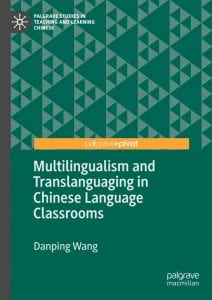 Multilingualism and Translanguaging in Chinese Language Classrooms by Danping Wang presents research on Chinese as a Second Language (CSL) teaching and learning practices based on an ethnographic classroom study. This book exposes the complex language use in second language classrooms and the debates on monolingual and multilingual teaching methods and practices. It provides the basics of classroom translanguaging research to help equip second language teachers in assessing their classroom practices. Throughout the book, Wang emphasizes how language policy and practices should consider the diverse backgrounds and support the different needs of multilingual students.
Multilingualism and Translanguaging in Chinese Language Classrooms by Danping Wang presents research on Chinese as a Second Language (CSL) teaching and learning practices based on an ethnographic classroom study. This book exposes the complex language use in second language classrooms and the debates on monolingual and multilingual teaching methods and practices. It provides the basics of classroom translanguaging research to help equip second language teachers in assessing their classroom practices. Throughout the book, Wang emphasizes how language policy and practices should consider the diverse backgrounds and support the different needs of multilingual students.
Wang begins by introducing the context of the study and summarizing the major events and challenges that affect Hong Kong’s CSL programs. After the transfer of Hong Kong’s sovereignty in 1997, the government required the citizens to acquire Mandarin in addition to Cantonese and English. However, unequipped teachers and the “one-size-fits-all monolingual curriculum” (p. 5) could not support the needs of learners with diverse cultural and linguistic backgrounds whose numbers were rapidly increasing. Elaborating on these challenges, Wang highlights the urgent need of transforming the second language curriculum and pedagogy to support multilingual learners.
Chapter 2 dives deeper into the issues regarding the “medium of instruction (MoI) policies and pedagogies in CSL teaching” (p. 17). Despite having different cultural and linguistic backgrounds, CSL programs across the globe usually have similar MoI policies. Moreover, some teachers undervalue the role of learners’ home language in learning a second language. As a result, communication issues among teachers and students increase whereas students’ motivation decreases.
After presenting the challenges and background of Chinese as a Second Language pedagogy, in Chapter 3 Wang discusses the theories and approach of this study. The key concepts that set the foundation of this research include the origins of the monolingual principle and criticisms against it as well as theories about second language learning, sociocultural, ecology, multi-competence, and translanguaging. Wang further elaborates on the ethnographic classroom research design, research context, and the two research questions examining: 1) the functions of L1 use in L2 classrooms and 2) teachers' and students’ attitudes on monolingual/multilingual learning and teaching practices.
In Chapter 4, Wang discusses the results of this ethnographic classroom study, focusing on the translanguaging practices and perceptions of the students, teachers, and course developers. The findings suggest that most of the translanguaging practices in this study were for scaffolding purposes. Moreover, Wang provides guiding principles for teachers to incorporate translanguaging in their teaching practices while leveraging the learners’ home languages as an asset to acquire new languages.
In the last chapter, Wang invites us to rethink and ponder some key concepts including “code-switching, medium of instruction, native speaker, English as a lingua franca” in second language teaching and learning (p. 97). The detailed guiding principles of classroom translanguaging research provide teachers with the foundation to evaluate and improve their pedagogical practices, freeing them from monolingual principles.
This research raises great challenges to the generally acknowledged monolingual CSL curriculum and pedagogy while introducing translanguaging practices that teachers can incorporate to better understand and support multilingual learners. The book will help us as educators to enhance our understanding of second language pedagogy and provide opportunities for our diverse students to contribute their multilingual assets to the classroom.
